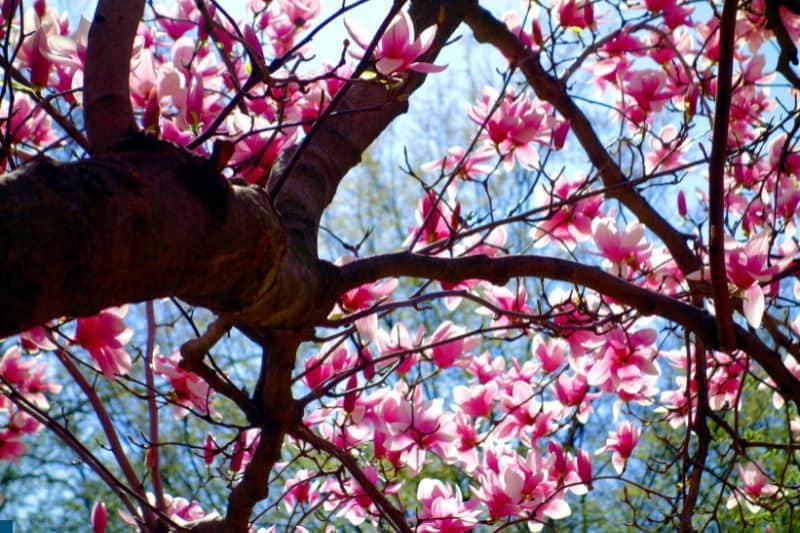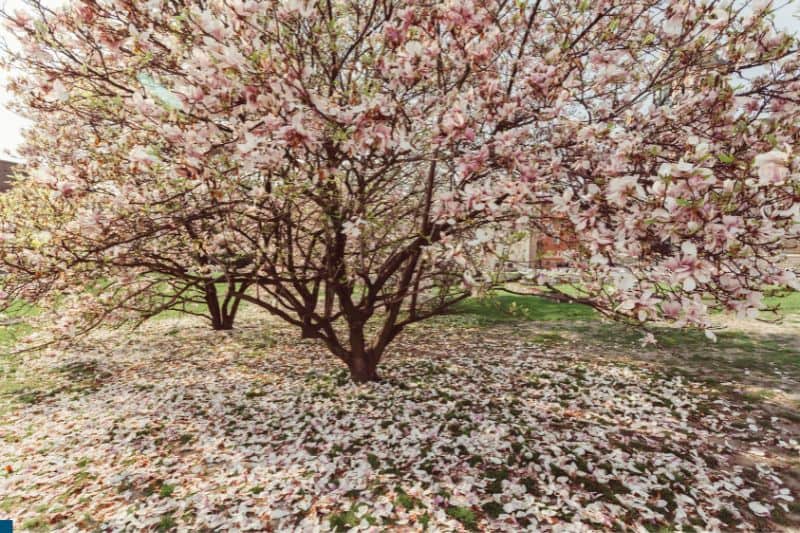Magnolia trees are prized for their spectacular springtime flowers. While most people picture the iconic southern magnolia with its waxy leaves and beautiful blooms when they think of magnolias, there are actually many varieties of magnolia trees. With so many types and hybrids, you can find magnolia trees throughout the United States.
Since almost anyone can grow a magnolia tree in their yard or garden, you may wonder if they lose their leaves.
Magnolia trees lose their leaves throughout the year to make room for new growth. Evergreen magnolia trees will keep most of their leaves in the winter while deciduous magnolia trees will lose all their leaves during the cold season. Which type of magnolia you can plant depends on your region and desires.
Read: How Fast do Mimosa Trees Grow?
Do Magnolia Trees Lose Their Leaves In The Winter?
When it comes to planning your garden or landscape, it’s best to know when plants bloom and if they lose their leaves during the colder seasons. This will help you prepare for any dead spots. Many people like to include flowering shrubs and trees in their lawns or gardens; magnolia trees are a favorite.
Magnolia trees are known for their bold blooms and showy springtime flowers, but do they lose their leaves in the winter?
While some species of magnolia trees, like the southern magnolia, are evergreen and keep most of their leaves all year round, most species are deciduous and will drop their leaves in the autumn and remain dormant until springtime.
Magnolia trees will begin to drop their leaves as the colder months settle in. Generally, the cold weather puts deciduous trees into dormancy where they conserve their energy.
Since leaves require a large amount of energy to keep, repair, and grow, they drop them to help overwinter. Deciduous trees and plants will store their energy to bud new leaves in the springtime.
In the case of magnolia trees, they are storing their energy to bloom with both new leaves and their iconic springtime flowers. Luckily, they bloom early in the southern parts of the United States, where the winters aren’t freezing.
Why Do Magnolia Trees Lose Their Leaves?
Magnolia trees lose their leaves as a way to help conserve energy during times when the sun isn’t as abundant. This is true for every deciduous plant or tree. These plants drop their leaves to save energy during the winter months since the sun is needed to perform photosynthesis and the sun doesn’t shine enough during this time of the year.
Instead of attempting to grow new, repair damaged, or keep their current set of leaves alive and thriving, they store their energy. Similar to how a seed can store enough energy to sprout even when there is no sun, deciduous trees and plants grow new leaves once springtime arrives.
These small buds will grow into new leaves that will help the plant create energy through the process of photosynthesis during the sunny months. This energy will be used to grow, repair, bloom, and create new life for the tree or plant. Then, when the temperature drops, the plant will drop its leaves as a way of preserving itself.
Many plants and even insects will enter a dormant period during the cold winter months, especially in places with freezing winters. Evergreen trees and plants will remain green all year long and can even produce their seeds during the cold months.
When Do Magnolia Trees Lose Their Leaves?
Deciduous magnolia trees will lose their leaves as self-preservation when the cold winter months roll in. Since the tree would be spending too much energy and not receiving enough sunlight, deciduous trees enter a dormant period, similar to a seed waiting to be planted to sprout the next year.
Since we know we can expect most magnolia trees to be deciduous, even though a few varieties are evergreen, when do magnolia trees lose their leaves?
Magnolia and other deciduous trees will lose their leaves during mid to late autumn with the entirety of their canopy lost before winter. During Autumn, trees will begin to drop their leaves. During this process, the leaves turn vibrant colors of red, orange, red, yellow, and brown as they prepare to fall. Magnolia tree leaves will turn yellow as they fade.
Magnolia trees lose their leaves more than just once a year. While deciduous magnolia trees will go dormant and lose their entire canopy during the late autumn and early winter, they and their evergreen counterparts also continuously drop their leaves all year long as they grow new ones.
During the spring, summer, and early autumn, you may notice a few yellowing magnolia leaves on your tree. These leaves are old and dying and will soon fall off before being replaced by fresh new buds.
While a few yellowing leaves is normal and to be expected, many yellowing leaves can be a sign that something is wrong with your magnolia tree and should be taken seriously.

How Many Times a Year Do Magnolia Trees Bloom?
Since magnolia trees are known for their bold blooms, many people who are unfamiliar with these trees often wonder how often they bloom. While the showy flower display is stunning, it can leave your yard with a large mess of soggy petals as the flowers fade and fall.
If you are planning to add a magnolia tree to your landscape, knowing how many times a year it blooms can be helpful to decide whether or not the plant is right for you.
Mature magnolia trees will bloom every season. Most varieties of magnolia trees only bloom once a year. Generally, they bloom early in your USDA region’s springtime. Some varieties of magnolia trees will bloom twice a year, once in early spring and again in late summer.
Knowing that your magnolia tree will bloom every year once it reaches maturity gives a homeowner or gardener something to look forward to. These trees tend to be one of the first to bloom each springtime, giving a lovely pink floral backdrop to an otherwise gray early spring. However, as the flowers fade, they will fall and the petals can quickly take over your yard as magnolia trees can grow very large.

Do Magnolia Leaves Grow Back?
Seeing your tree drop leaves can be disheartening and stressful, especially if you are wondering if the leaves will grow back. When it comes to magnolia trees, you may notice yellowing leaves that fall off. Do magnolia leaves grow back?
Both evergreen and deciduous magnolia trees will lose leaves and grow back throughout the year. Deciduous magnolia trees will also drop the entirety of their leaves in autumn.
Evergreen magnolia trees are constantly growing new leaves throughout the year. Old leaves will turn yellow before falling off and will be replaced by a new bud. Generally, evergreen magnolia trees experience drooping and yellowing leaves as they begin to bloom in the springtime. This is because the tree focuses most of its energy on producing blooms rather than repairing the leaves.
Deciduous magnolia trees will drop the entirety of their canopies in autumn and remain bare during the winter until springtime. While the process is completely natural, it can be alarming to see your magnolia bare, but don’t worry because the tree will regrow all new leaves once the warm weather returns.
How Do You Keep a Magnolia Tree Healthy?
While southern magnolias are iconic and classic, there are magnolia varieties that can be grown almost anywhere in the United States. Each different type requires slightly different things to be healthy and thrive, but magnolias tend to be low maintenance.
Evergreen magnolias prefer to be planted in full sun while deciduous magnolias enjoy partial shade. Small trees need more water, but mature trees can tolerate some drought and hot summers. Magnolias don’t need to be pruned unless you’re trying to shape them or remove some dead branches.
Luckily, magnolia trees don’t need fertilizing and will survive with little intervention from humans. In fact, staying away from a magnolia tree may be what’s best as their root systems are shallow and can easily be damaged.
When it comes to magnolia trees, they can live for centuries. During that time, they can grow to be 80 feet tall and 40 feet wide! This is common to see with the iconic and classic southern magnolia which is what most people think of when picturing a magnolia tree.
Read: When Do Maple Trees Bloom? (Answered)
How to Tell if a Magnolia Tree is Dying?
Brittle branches, peeling bark, dropping or discolored leaves, and cracks in the wood of the tree are generally signs that something is wrong with your magnolia tree. Paying close attention to your tree’s leaves will allow you to intervene early in case of an emergency or disease.
Generally, magnolia trees can be saved if the problem is caught early enough. Using the appropriate solution and spraying on the tree is best in fungal infections or disease cases. Remove the infected leaves and branches to minimize the spread and always treat open tree wounds in the bark with alcohol solution and tree pain to help prevent rot.
Over watering your magnolia tree can lead to waterlogged roots which can cause serious problems for your tree. Mature magnolias can tolerate slight drought, so avoid watering unless the leaves begin to shrivel. Even then, water sparingly to avoid water logging the tree and be sure the tree is growing in well-draining soil.






